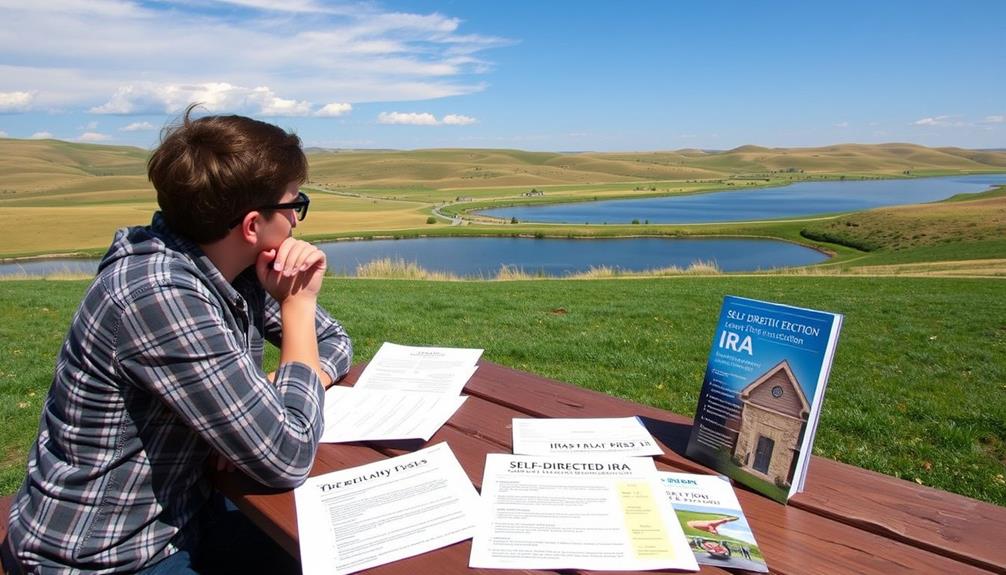Retirement planning in South Dakota involves integrating your IRAs with state-specific benefits such as the South Dakota Retirement System (SDRS). Begin by incorporating Traditional or Roth IRAs into your plan to maximize tax advantages and investment options. Utilizing the Supplemental Retirement Plan (SRP) can further increase your savings. Combining these accounts with SDRS can help address any financial gaps you may have. While self-directed IRAs offer potential benefits, it is important to be aware of the risks involved. By taking the right approach, you can optimize your retirement strategy. Learn how to customize these tactics effectively to safeguard your financial future.
Key Takeaways
- Combining South Dakota Retirement System (SDRS) benefits with Individual Retirement Accounts (IRAs) enhances overall retirement savings and financial flexibility.
- Traditional IRAs offer tax-deferred growth, while Roth IRAs provide tax-free withdrawals, maximizing tax advantages for retirees.
- South Dakota's Supplemental Retirement Plan (SRP) complements SDRS with tax-advantaged contributions, including catch-up options for those aged 50 and older.
- Diversifying investments across SDRS, SRP, and IRAs can lead to higher returns and effective risk management in retirement planning.
- Engaging with financial advisors helps optimize retirement strategies by clarifying contribution limits and aligning investments with personal retirement goals.
Understanding South Dakota Retirement Plans

When it comes to retirement planning in South Dakota, understanding the available retirement plans is essential for securing your financial future.
The South Dakota Retirement System (SDRS) plays an important role for public employees, including state, municipal, and educational workers. Membership in SDRS is mandatory for full-time employees, ensuring they receive retirement benefits after a typical vesting period of three years.
The SDRS offers a variety of benefits, including retirement, disability, and survivor benefits, with payouts calculated based on years of service and salary.
For those looking to enhance their retirement savings, the Supplemental Retirement Plan (SRP) is another option. It allows eligible employees to make tax-advantaged contributions, providing both pre-tax and Roth options, along with catch-up contributions for individuals aged 50 and older.
Overview of IRAs and Their Benefits

When planning for retirement, understanding the different types of Individual Retirement Accounts (IRAs) is essential. You can take advantage of their tax benefits, whether you choose a Traditional IRA for pre-tax contributions or a Roth IRA for tax-free withdrawals.
Additionally, exploring options like converting a 401k to a Gold IRA can enhance your portfolio's protection against inflation and market downturns, providing an effective hedge during economic volatility (IRA Rollover to Gold).
Plus, knowing the contribution limits can help you maximize your savings potential.
Types of IRAs
Understanding the different types of Individual Retirement Accounts (IRAs) can greatly enhance your retirement planning strategy. There are two primary types to ponder: Traditional IRAs and Roth IRAs.
A Traditional IRA allows you to make pre-tax contributions, meaning you can deduct your contributions from your taxable income, which may lower your tax bill now. The funds grow tax-deferred until you withdraw them during retirement, at which point they're taxed as ordinary income.
Additionally, many investors are exploring options like Gold IRAs to diversify their portfolios and protect against inflation, making it essential to contemplate precious metal investment options when planning for retirement.
On the other hand, Roth IRAs require after-tax contributions, so you pay taxes on your money upfront. The benefit? Your withdrawals in retirement are tax-free, provided you meet certain conditions. This can be particularly advantageous if you expect to be in a higher tax bracket later in life.
In 2024, you can contribute up to $7,000 if you're under 50, and $8,000 if you're 50 or older, allowing for catch-up contributions.
Both types of IRAs offer investment flexibility, allowing you to invest in stocks, bonds, and even alternative assets. Integrating these IRAs into your retirement plan can help you take full advantage of your savings potential.
Tax Advantages Explained
Tax advantages play an essential role in making Individual Retirement Accounts (IRAs) an appealing option for your retirement planning. With traditional IRAs, you can enjoy tax-deferred growth, meaning your contributions reduce your taxable income for the year you make them. This feature enhances your ability to save more effectively for your future.
Additionally, investing in a Gold IRA can provide further diversification and long-term capital appreciation, acting as a hedge against inflation and economic downturns Gold IRAs offer diversification. On the other hand, Roth IRAs offer the enticing benefit of tax-free withdrawals in retirement, allowing you to access your funds without worrying about taxes.
For the tax year 2024, you can contribute up to $7,000 to your IRA, with an extra $1,000 catch-up contribution if you're 50 or older. Depending on your income and participation in employer-sponsored plans, your contributions to traditional IRAs may be fully or partially tax-deductible, further maximizing your tax benefits.
The growth of your investments within an IRA isn't subject to taxes until you take distributions, which greatly aids in long-term retirement planning.
As a South Dakota resident, you can effectively integrate these tax benefits with state-specific retirement savings plans like the South Dakota Retirement System (SDRS) to create an all-encompassing strategy for your financial future.
Contribution Limits Overview
Steering through the complexities of retirement contributions can feel overwhelming, but knowing the limits can empower you to make informed decisions. For 2024, the contribution limit for traditional and Roth IRAs is set at $7,000, with an additional catch-up contribution of $1,000 for those aged 50 and older.
In comparison, 401(k) plans allow for a more substantial contribution limit of $23,000, along with a catch-up option of $7,500 for older participants.
Understanding these contribution limits is vital for effective retirement planning. Contributions to traditional IRAs may be tax-deductible based on your income and participation in employer-sponsored plans, while Roth IRA contributions grow tax-free after being made with after-tax dollars.
As a South Dakota resident, you can also benefit from state-specific retirement programs that may involve automatic enrollment for eligible employees, which can complement your IRA contributions.
It's important to be aware of the combined contribution limits across various retirement accounts to maximize your tax-advantaged savings effectively. By staying informed, you can better navigate your financial future and make the most of your retirement planning.
State-Specific Retirement Benefits

In South Dakota, public employees rely heavily on the South Dakota Retirement System (SDRS) for their retirement benefits, as the state lacks a mandated retirement plan. SDRS provides pension benefits based on a formula that factors in your years of service and salary.
With a typical vesting period of three years, you'll need to contribute a percentage of your salary to build your retirement security over time.
Additionally, you might benefit from cost-of-living adjustments (COLA) that help maintain your purchasing power during retirement.
Besides SDRS, Supplemental Retirement Plans (SRPs) offer valuable tax-advantaged savings options designed to complement your pension.
Here are some key features of South Dakota's retirement benefits:
- SDRS benefits are based on years of service and salary.
- Mandatory contributions help build retirement security.
- COLA may enhance financial stability for retirees.
- SRPs provide flexible investment choices.
- Contribution limits vary depending on individual financial goals.
Understanding these state-specific retirement benefits can empower you to make informed decisions as you plan your retirement in South Dakota.
Integrating IRAS With SDRS

Integrating IRAs with your South Dakota Retirement System (SDRS) benefits can greatly enhance your retirement savings strategy. By combining these two options, you can create a more thorough retirement plan tailored to your financial goals.
SDRS provides pension benefits for public employees, but relying solely on these benefits mightn't meet all your retirement needs. That's where an IRA comes into play.
You can contribute to both your SDRS and an IRA, allowing for greater flexibility and potential growth. In 2023, you can put aside $6,500 annually if you're under 50, or $7,500 if you're 50 and older. This means you can complement your SDRS pension with additional savings that can be invested in various assets through an IRA, enhancing your portfolio's diversity.
While SDRS primarily offers defined benefit plans, integrating IRAs allows you to address your unique risk tolerance and investment preferences.
By leveraging the stability of SDRS pension benefits alongside the flexibility of your IRA, you can build a robust retirement plan that positions you for financial security in your golden years.
Don't miss out on maximizing your retirement savings potential!
Advantages of Self-Directed IRAs

Self-Directed IRAs can greatly enhance your investment strategy by offering a wider array of options than traditional IRAs.
With the flexibility to invest in various assets, you can tailor your portfolio to meet your unique financial goals. Additionally, understanding common financial terms can help you make informed decisions regarding your investments.
Here are some key advantages:
- Broader investment options: Invest in real estate, private companies, or cryptocurrencies for better diversification.
- Tax advantages: Enjoy tax-deferred growth on your investments until withdrawal, leading to potentially greater wealth accumulation.
- Greater control: You decide where and how your money is invested, aligning investments with your market knowledge.
- Potential for higher returns: Alternative investments within Self-Directed IRAs may yield substantial profits compared to conventional investment options.
- Enhanced financial security for beneficiaries: Strategic asset allocation and management can provide a more stable financial future for your loved ones.
Risks of Self-Directed IRAs

The allure of Self-Directed IRAs can quickly be overshadowed by their inherent risks. While you have control over your investments, this autonomy comes with significant responsibilities. You must conduct thorough due diligence, as these accounts lack regulatory oversight on non-traditional assets. If you fail to research properly, you could face severe financial consequences.
Many alternative investments, like real estate or private equity, can create liquidity challenges. Selling these assets may take considerable time, potentially delaying your access to funds when you need them most.
Additionally, managing a Self-Directed IRA requires strict adherence to IRS rules to maintain its tax-advantaged status. Ignoring these regulations can lead to hefty penalties.
Valuing non-traditional assets can also be tricky. The subjective nature of valuations often necessitates professional appraisals to guarantee compliance with IRS regulations.
In addition, unintentional violations, such as engaging in prohibited transactions, could trigger taxes on the entire account value, jeopardizing your retirement savings. As a result, it's vital to consult a financial advisor to navigate these complexities and mitigate risks associated with Self-Directed IRAs effectively.
Role of Financial Advisors

Steering through the complexities of retirement planning can be intimidating, especially when dealing with the risks associated with Self-Directed IRAs. That's where financial advisors come in. They play a vital role in helping you navigate your retirement plans.
By integrating state-specific benefits like the South Dakota Retirement System (SDRS) with your individual retirement accounts (IRAs), they can craft personalized strategies that fit your needs.
Here are a few ways financial advisors can assist you:
- Understand contribution limits: They'll clarify the $7,000 limit ($8,000 for those 50+) for 2024, optimizing your tax advantages.
- Investment options: Advisors help you choose investments in the SDRS and Self-Directed IRAs that align with your goals and risk tolerance.
- Stay updated: They keep you informed about legislative changes that affect retirement plans and compliance.
- Account consolidation: Financial advisors can streamline your retirement savings by consolidating 401(k)s and IRAs into a cohesive strategy.
- Personalized education: They provide valuable insights on maximizing your state retirement plan benefits.
With their expertise, you can confidently navigate your retirement planning journey.
Strategies for Effective Retirement Planning

When planning for retirement in South Dakota, you'll want to combine the benefits of the South Dakota Retirement System (SDRS) with self-directed IRAs to maximize your savings.
Diversifying your investment options can lead to higher returns and better risk management.
Don't forget to take advantage of tax benefits to enhance your financial strategy as you prepare for retirement.
Combining SDRS and IRAs
Combining SDRS benefits with IRAs can greatly enhance your retirement strategy in South Dakota. By strategically integrating these two retirement resources, you can enjoy the tax advantages and financial security they offer.
The South Dakota Retirement System (SDRS) provides a solid foundation with its pension benefits, while IRAs, especially Self-Directed IRAs, allow for greater investment flexibility.
Here are some effective strategies for combining SDRS and IRAs:
- Leverage Tax Advantages: Use traditional IRAs for tax-deferred growth or Roth IRAs for tax-free withdrawals.
- Diversify Your Portfolio: Invest in alternative assets like real estate or precious metals through your IRA.
- Maximize Retirement Income: Use SDRS's cost-of-living adjustments (COLA) alongside your IRA payouts.
- Plan for Longevity: Guarantee you have a balanced approach to meet long-term retirement needs.
- Monitor Your Investments: Regularly assess your combined SDRS and IRA performance to stay on track.
Diversifying Investment Options
A well-diversified investment portfolio is essential for effective retirement planning, especially in South Dakota. By diversifying your investment options, you can greatly reduce volatility risks and enhance your potential returns. You might consider spreading your assets across various asset classes, including stocks, bonds, and real estate.
Utilizing a Self-Directed IRA can further improve your diversification strategy, allowing investments in non-traditional assets like startups and private companies. Here's a quick comparison of investment options:
| Investment Type | Description |
|---|---|
| Stocks | Ownership in companies, potential for growth |
| Bonds | Fixed income investments, lower risk |
| Real Estate | Tangible assets, potential rental income |
| Precious Metals | Hedge against inflation and market volatility |
| Cryptocurrencies | High risk, high reward potential |
Engaging with financial advisors can help tailor your portfolio to match your risk tolerance and financial goals. With the South Dakota Retirement System's Supplemental Retirement Plan (SRP), you can choose from a variety of investment options, ensuring your retirement strategy aligns with your long-term objectives. Balancing your investments is key to a secure retirement.
Maximizing Tax Advantages
Maximizing tax advantages is a key strategy in effective retirement planning, especially in South Dakota. By utilizing a Self-Directed IRA, you can enjoy tax-deferred growth, allowing your account balance to increase without immediate taxation.
Additionally, South Dakota's Supplemental Retirement Plan (SRP) offers both pre-tax and Roth contribution options, giving you flexibility in managing your taxable income.
To guarantee you're making the most of available tax benefits, consider these strategies:
- Utilize catch-up contributions if you're 50 or older to boost your maximum contributions.
- Combine state-mandated plans like the SRP with personal IRAs for a diversified savings approach.
- Engage with financial advisors to navigate retirement legislation effectively.
- Monitor your account balance regularly to stay on track with your retirement goals.
- Stay informed on changes in retirement legislation that may affect your tax advantages.
Future of Retirement Mandates in South Dakota

The landscape of retirement planning in South Dakota is poised for change as discussions around future mandates gain attention. Currently, South Dakota doesn't have any state-mandated retirement plans, leaving many households without sufficient retirement savings. This gap highlights the potential need for future mandates that could require employers to offer retirement savings options to their employees.
Unlike states like California and Oregon, where retirement plan legislation has gained traction, South Dakota has yet to adopt similar measures. This places employers in a unique position; they can choose to implement private retirement plans or wait for possible future mandates from the state.
As you navigate this uncertain landscape, it's crucial to stay informed about national trends and legislative developments. Employers should recognize that the conversation surrounding retirement savings is evolving.
As concerns about retirement security grow, future mandates could emerge to address these issues. By keeping an eye on potential changes, you can better prepare your business and employees for what lies ahead. Engaging in proactive retirement planning now may help you stay ahead of the curve and guarantee your workforce is financially secure in the future.
Frequently Asked Questions
Can You Combine State and Federal Retirement?
Yes, you can combine state and federal retirement accounts. By rolling over funds and adhering to regulations, you'll enhance your retirement strategy, benefiting from both state-sponsored plans and federal tax advantages for a more secure future.
What Is the South Dakota Retirement System Pension Plan?
The South Dakota Retirement System pension plan provides mandatory benefits for public employees. It calculates retirement payouts based on service years and average salary, ensuring financial support through disability and survivor benefits for members and beneficiaries.
What Is the Rule of 85 for Retirement in South Dakota?
The Rule of 85 in South Dakota lets you retire early if your age plus years of service equals 85. This provides flexibility and encourages you to plan your retirement more effectively.
Is South Dakota Retirement Friendly?
Imagine enjoying retirement in South Dakota without state income tax. You'll find it retirement-friendly, offering stable income through the SDRS, flexible savings options, and cost-of-living adjustments to help maintain your purchasing power.
Conclusion
As you navigate the winding river of retirement planning in South Dakota, remember that your IRAs are like sturdy oars guiding your boat. By integrating state-specific benefits and leveraging the expertise of financial advisors, you can steer toward a secure financial future. Embrace the journey with self-directed IRAs, but stay mindful of potential risks. With thoughtful strategies, you'll not only reach your destination but also enjoy the scenic views along the way. Your retirement adventure awaits!









